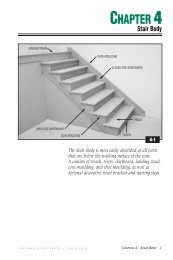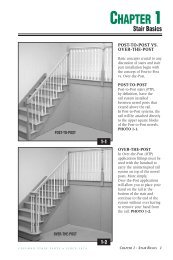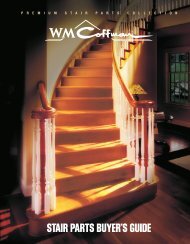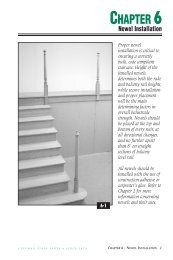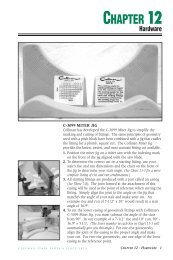Policies, Terms And Conditions Of Sale - WM Coffman
Policies, Terms And Conditions Of Sale - WM Coffman
Policies, Terms And Conditions Of Sale - WM Coffman
Create successful ePaper yourself
Turn your PDF publications into a flip-book with our unique Google optimized e-Paper software.
NEWEL<br />
NO<br />
NEWEL<br />
2nd FLOOR<br />
PLATFORM<br />
C-7281<br />
C-7081<br />
Left Hand<br />
C-7050 C-7055<br />
Left Hand Right Hand<br />
2 Riser No Cap<br />
With Cap<br />
C-7286<br />
C-7086<br />
Right Hand<br />
SPECIALTY FITTINGS<br />
OVER EASING<br />
An over easing is<br />
designed to carry<br />
the rail system<br />
from the rake<br />
(angled) portion<br />
of the stair to the<br />
2nd FLOOR<br />
PLATFORM<br />
NO<br />
NEWEL<br />
level, balcony portion without the use of a<br />
gooseneck. This elegant, flowing look is<br />
achieved by combining the over easing<br />
with a transitional fitting such as a<br />
tandem cap.<br />
90° UP EASING<br />
90° up easings are used to make a<br />
horizontal to vertical 90° transition in a<br />
rail system.<br />
S-SERIES FITTINGS<br />
<strong>WM</strong> <strong>Coffman</strong>’s<br />
S-Series fittings<br />
accommodate the<br />
continuous rail codes<br />
on partial-open<br />
stairs. Specify Right-<br />
Hand or Left-Hand<br />
(from the bottom of<br />
the stair looking up).<br />
C-7013<br />
OVER EASING<br />
C-7089 (LOWER EASING DISCARDED)<br />
NEWEL<br />
Ordering Specifications for Fittings<br />
SUGGESTED GOOSENECKS FOR SOME COMMON APPLICATIONS<br />
C-7020 TANDEM CAP<br />
C-7014S<br />
90° UP EASING<br />
C-7047<br />
LEFT-HAND<br />
S-FITTING<br />
Check local building codes for required height and baluster spacing.<br />
NEWEL<br />
5 1/2" Center of Rail<br />
to Center of Rail<br />
PLATFORM<br />
2nd FLOOR2nd FLOOR<br />
WELLHOLE 5 1/2"<br />
WELLHOLE 5 1/2"<br />
C-7291<br />
C-7091<br />
Left Hand<br />
C-7294<br />
C-7094<br />
Right Hand<br />
Landing Return<br />
C-7060 C-7065<br />
Left Hand Right Hand<br />
2 Riser With Cap<br />
C-7019 OPENING CAP C-7007 COPED END<br />
37<br />
PLATFORM<br />
NEWEL<br />
NO<br />
NEWEL<br />
NEWEL NEWEL<br />
C-7297<br />
C-7097<br />
With Cap<br />
RAIL PROFILE<br />
COPED (SHAPED)<br />
INTO END OF<br />
FITTING<br />
COPED ENDS<br />
Some <strong>WM</strong> <strong>Coffman</strong> families contain a<br />
Coped End which is a fitting that has the<br />
profile of the rail shaped, or coped, into<br />
one end of a straight piece of rail. This<br />
fitting is used in conjunction with an<br />
opening cap (Example C-7019) or a<br />
gooseneck incorporating an opening cap<br />
(Example C-7097), to accomodate<br />
nonstandard angle changes.<br />
C-7086 TWO-RISE GOOSENECK WITH CAP<br />
C-7011 LEVEL<br />
QUARTERTURN NO CAP<br />
COMBINING FITTINGS<br />
Standard fittings will sometimes have to<br />
be site-assembled to complete a height<br />
and/or directional transition. Basically all<br />
stair applications can be satisfied using a<br />
combination of currently available <strong>WM</strong><br />
<strong>Coffman</strong> fittings.<br />
In the example shown of a 180° turn<br />
at balcony, you will need a two-rise<br />
gooseneck with cap that turns right 90°<br />
to sit on top of the newel along with a<br />
level quarterturn without a cap to<br />
complete the 180° turn.<br />
2nd FLOOR<br />
C-7289<br />
C-7089<br />
With<br />
Tandem Cap<br />
C-7271<br />
C-7071<br />
Left Hand<br />
No Cap<br />
C-7276<br />
C-7076<br />
Right Hand<br />
2nd FLOOR<br />
NO<br />
NEWEL<br />
SQUARE TOP<br />
NEWEL<br />
STANDARD VOLUTE<br />
(C-7035) FOR 34"<br />
RAKE RAIL HEIGHT<br />
C-7299<br />
C-7099<br />
No Cap<br />
ASCENDING VOLUTE<br />
C-7033 FOR SAME 34"<br />
RAKE RAIL HEIGHT<br />
ASCENDING VOLUTES<br />
<strong>WM</strong> <strong>Coffman</strong>’s ascending volutes<br />
(C-7X33, C-7X38) are designed to begin<br />
their ascent much sooner than their<br />
standard counterparts, allowing for the<br />
use of a shorter newel and shorter<br />
balusters on top of the bullnose starting<br />
step. This lower, more proportional<br />
beginning of an Over-the-Post system,<br />
coupled with the graceful, flowing<br />
transition from the volute to the rail,<br />
makes the ascending volute an attractive<br />
addition to any stair.



